I hear people say this a lot, especially students who are training to become elite athletes.
On top of going to school, these students are often training for 15-30 hours every week. So I’m often asked . . .
“How do I find time to study? Do you have any tips?”
I can’t say to these students, “Put your phone on silent!” or “Use an Internet Blocker app”.
Why?
Because these students aren’t faffing around on social media. They’re not procrastinating.
They are incredibly disciplined, often rolling out of bed for training at 4.30am while the rest of us are snoozing.
So what do I tell these students?
I tell them about Jack and his highly original study method.
I met Jack after delivering a presentation to his year group on effective study strategies. He came up to me and was keen to share how he studied. He said he was happy for me to share his study method.
Jack is in year 11. Like many young people, he leads a busy life.
He belongs to a swim club where he trains several times a week. This leaves Jack with very little time to sit down and study after school.
Like many students with sporting commitments, he would ask himself the question . . .
“How do I find time to study?”
Jack had tried squeezing in study before swim training. But he said that didn’t work so well.
Then he had a brilliant idea. What if he didn’t sit and study? What if he combined swim training with study? Could that work?
With the help of his swim coach, he devised a plan.
Jack would arrive at swim training and proceed to do laps in the pool as per usual.
The only difference would be that after a lap, when he touched the wall, his coach would ask him a question from his stack of flash cards. Nothing too complex. Just simple stuff like “What is the function of the frontal lobe?” or “What is the Bystander Effect?”
It didn’t matter that his coach didn’t understand the question or content.
If Jack got the question right, he’d get an extra 10 seconds rest before going off to do another lap.
But if he got the question wrong?
His coach would tell him the right answer and send Jack off to do another lap straight away.
But it didn’t stop there.
Jack’s friend from the swim club decided to give the strategy a shot at training, too. So they’d do a lap together, get to the wall and then quiz each other on subjects they were both studying.
Now Jack’s swim coach is quizzing several students at training, juggling different sets of flashcards as students do laps of the pool.
Jack swears by this method. He says it delivers results. But he also acknowledges this method wouldn’t work so well if his amazing coach wasn’t on board.
I thought about all the times I had gone for walks to practice upcoming presentations (walking and talking out loud). This was effective but sometimes I wanted to switch off from my work and just walk and relax. I wondered if Jack ever felt this way, too.
So I asked Jack if he ever just wanted to swim (and not combine it with study).
He said:
“Yes, of course. Sometimes if I’m not feeling it, I won’t force it. But if I’m feeling up to it, I’ll do a little study.”
Sometimes when you’re faced with a challenge in life, you need to think a little creatively to come up with solutions.
You may not be a swimmer like Jack but there’s a good chance there are activities you already engage in where you could weave in a little quizzing.
If you’re willing to experiment and have a play, you may be pleasantly surprised by what you discover.
Share This:
You need to practice. And practice in a particular way.
If you’re preparing for a driving test, you can’t just study the Drive Safe Handbook (i.e., the theory and road rules).
You need to get behind the wheel of a car and drive.
Yes, it can feel uncomfortable and scary to begin with. But you’ll only improve your driving skills by pushing through the discomfort, placing your hands on the wheel and your foot on the accelerator.
If a person spent all their time only studying the road rules and never getting behind the wheel of a car, how would they go in the driving test?
It would be disastrous!
Yet, many students are approaching exams in a similar way.
These students are doing the equivalent of only studying the road rules handbook before the exam.
Here’s how they prepare for academic exams:
• By creating beautiful sets of notes
• By rereading their books and notes
• By highlighting their books and notes
• By rewriting their notes
• By summarising their notes
These are not effective ways to prepare for an exam.
Do these ways of revising feel nice and easy?
Yes. They certainly do.
But are they effective ways to remember information?
No.
Think about it like this . . .
What do you need to do in most academic tests and exams?
You have to read questions and pull the information out of your brain. Most of the time, you can’t look at your notes and books.
It’s just you and your brain.
You’re not being assessed on your ability to summarise information, your ability to reread your notes, or highlight information. So, why would you prepare for an exam in that way?
The best way to prepare for an exam is by practising remembering information. This is how you become masterful at answering questions with accuracy, speed, and confidence.
You don’t get that speed, confidence, and deep understanding by rereading your books and notes.
If you reread as an exam revision strategy, the only confidence you develop is fool’s confidence. You delude yourself into thinking you know it (“I’m ready!”). After reading your notes a few times, the ideas feel familiar to you (“I know this stuff”).
But trust me, you’ll struggle to retrieve the information in the exam.
Imagine yourself driving through red lights and failing to take the handbrake off before you leave the parking lot: that’s you . . . and it’s a fail.
I know this may sound harsh. But I’m speaking from personal experience.
In high school, it felt good to highlight my notes and reread them leading up to an exam. However, when it came crunch time, I was stressed out in the exam because I couldn’t retrieve the information. I felt embarrassed and confused by my results.
“But I studied so hard!” I’d cry. Why didn’t all those of hours of reading translate to better grades?
I wish someone had gently explained to me, “Yes, you did study hard. But you didn’t study effectively”.
Fast forward 20 years and I’ve learnt how to study smarter (not harder).
“The best way to prepare for any test or exam is to use a learning technique called active recall.
Active recall involves testing yourself.
You push your notes and books to the side and try to bring to mind as much as you can about a topic you’ve already covered in class. For example, you can use a piece of paper to write or draw out what you can remember on the topic. Once you’ve exhausted your memory, you check your books and notes to see how you went.
Yes, this is challenging. But it delivers results.”
I use this technique to learn content for all my school presentations.
When I speak to a group of students, parents, or teachers, it may look like I’m casually explaining strategies, but all my presentations are carefully planned and practised.
If I didn’t do this critical prep work, I would end up rambling.
This is why two weeks ago, I started doing active recall to learn a new presentation —or at least, I thought I was doing active recall.
I pulled out a copy of my presentation slides that had my notes scribbled all over them.
Within the first five minutes, I had to stop and be honest with myself: I wasn’t doing active recall. I was reading my notes.
Many of us can fall into the trap of rereading when doing active recall.
As the Learning Scientists state in their book Ace That Test:
“When you try to bring information to mind from memory, it often feels really difficult. It can be really tempting to quit or try to look up all of the information in your notes or your textbook, but slipping into re-reading your notes or textbook will reduce learning. Instead, it is better to try to bring as much information to mind from your memory as you can, and only after you have tried this should you look in your notes, textbook, or other course materials to see what you got right and what you forgot or need to work on more.”
Reading your notes/books over and over again feels nice and easy. It doesn’t require a lot of strain and mental effort.
In contrast, active recall can make us feel clumsy and awkward, especially in the early stages of learning something new.
So, I asked myself the question:
How can I stop myself from rereading when I do active recall?
I brainstormed ideas and devised a plan. Then, I broke down the process and practised running through it several times. To my delight, it worked!
Whether you’re trying to learn a new presentation or preparing for an academic test or exam, here is a process you can follow to avoid the trap of rereading.
Clear away your notes, books, and any other distractions. Let’s face it: if your notes and phone are in front of you, it’s like having a packet of crisps or a bowl of lollies within arms’ reach. It’s too tempting.
Your notes are important (you need them for step 4), but for now, take them and place them away from your body in another room.
Active recall requires 100% of your brainpower. If your attention shifts from your study to your phone, the effectiveness of your active recall sessions decreases. This is why I highly recommend you put your phone away from your body in another room before you sit down to do active recall.
Once you’ve cleared away distractions, take out your practice exam paper or list of questions (in my case, a printout of my presentation slides) and get a pen, a timer, and some sticky notes.
Your goal for the next 10 minutes is to recall as much as possible. Exhaust your memory.
I scribble all over my slides (yes, it’s a messy process). If I run out of space on the page, I grab a sticky note, write the additional information on it, and then stick it down on the relevant slide.
During these 10 minutes, expect to experience some discomfort. In fact, welcome and celebrate the discomfort!
The discomfort is a sign that you are on the right track and deep learning is happening.
Active recall can be mentally exhausting. After doing 10 minutes, reward yourself by taking a quick break. I usually get up and move my body. Sometimes, I make myself a warm drink or smoothie.
Before returning to your workstation, grab your notes or the answer sheet from the other room.
It’s not enough to pull the information out of your brain. You have to see how you did (what you got right and wrong and where the gaps in your knowledge are).
So, how did you go?
At this point, enter teacher mode. Pretend to be a teacher giving yourself feedback.
I pull out my red gel pen, fun stamp and sticker collection, and highlighters.
Now is when it’s okay to look at your books and notes. Pull them out and begin marking up what you got right, wrong and anything important you missed.
In my case, if any presentation content is a bit rusty, I’ll highlight that section. The highlighter signals to my brain that this section needs extra practice.
It’s important to celebrate any content you recall correctly. Give yourself a tick, a fun stamp or sticker or draw a smiley face to congratulate yourself.
This is a process. It usually takes a few practice sessions to successfully retrieve the correct information. Encouraging yourself makes the process fun and gives you a feeling of success (“I’m making progress!”).
Once you finish step 4, make a note for your future self: what question or section will you work on for your next active recall session?
This reduces decision fatigue. When you next sit down to study this subject, there’s no need to waste precious mental energy thinking, “What should I revise next?” Your brain knows exactly what it needs to do, and you can begin doing active recall straightaway.
After you’ve decided on your starting point, prepare your workstation for your next active recall session (e.g., put your notes out of sight).
These six steps work for me. But feel free to modify this process so it works for you. For example, it can help to do active recall with others (e.g., in a study group with friends testing each other). When everyone experiences the discomfort together, the process becomes less painful and more enjoyable.
Active recall works, but paradoxically, it feels like it’s not working. Often, when I do active recall nothing comes to mind. That’s normal! Don’t use this as an excuse to abandon this highly effective strategy and return to rereading, which is an ineffective strategy.
My advice is to trust the process. You need to persevere with this strategy for long enough to see with your own eyes that it works. Don’t expect instant results. This process takes time, but the results are well worth it.
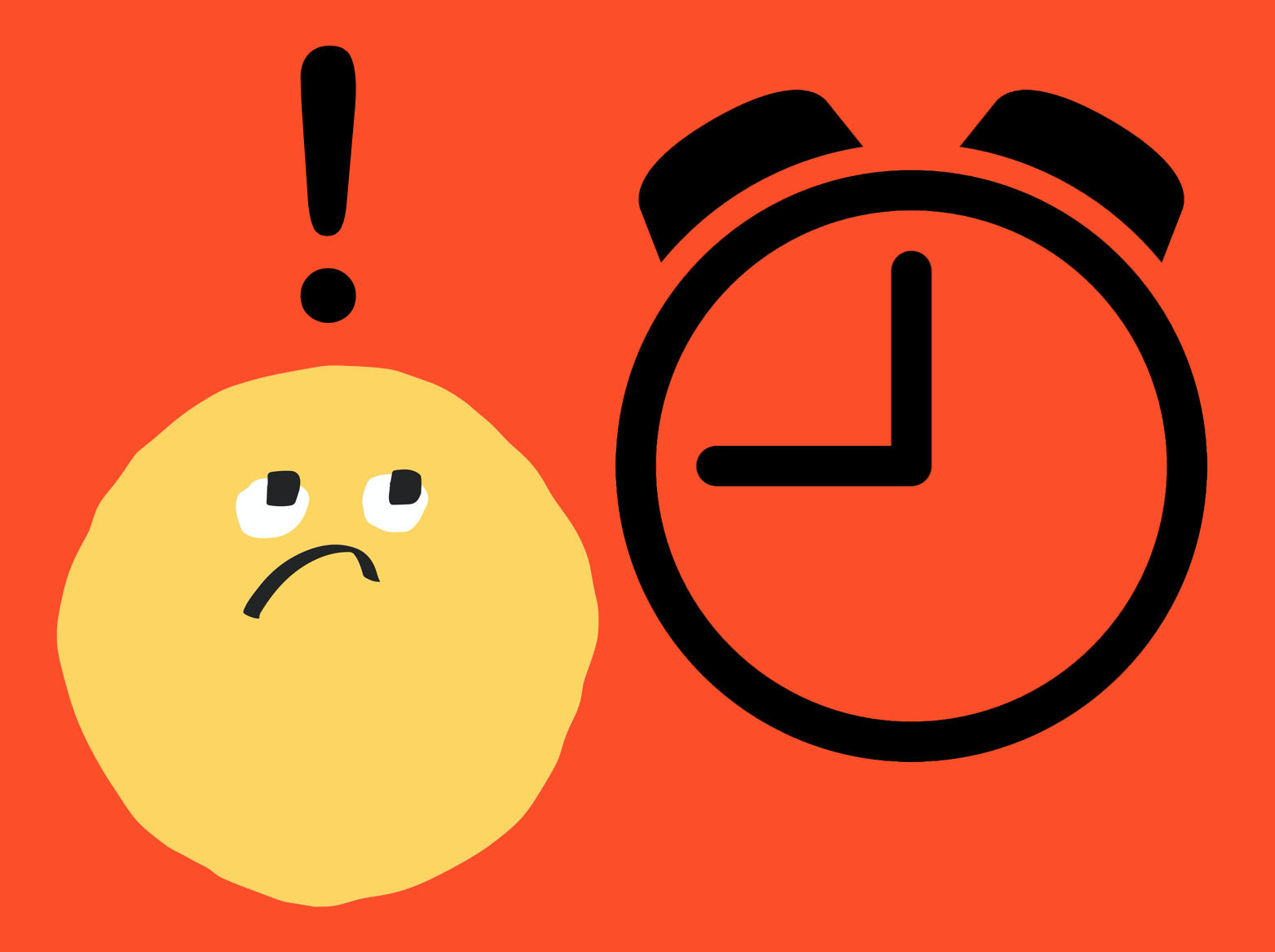
This is what my life used to feel like.
I was always in a rush.
Always cutting it fine.
Often running late.
I was late for class.
Late for dinner at friends’ houses.
Late for meetings.
In my world, being late was the norm. It was perfectly acceptable to drag your feet and rock up an hour late to an event.
So, I had to learn the hard way.
One morning, I was running late for school. I rocked up to form room three minutes late, and I knew straight away I was in trouble.
My form room teacher said:
“Jane, go to student services to get a late note. You’ve been late too many times. It’s not good enough”.
When you were told to go to student services, this was bad news. You were being told to do the walk of shame.
I pleaded with her:
“Please, no! Come on! It was my dad’s fault. He was late in driving me to school. My dad is always running late”.
My form room teacher wasn’t buying my excuses.
To this day, I can still remember that walk to student services. I felt frustrated and stressed out of my mind.
It wasn’t fun being late all the time. I wanted to be on time and feel less rushed and more in control. But I had no idea how to break this bad habit.
One thing was clear to me: people weren’t happy when I was late. People would get annoyed. Passive aggressive vibes were always coming my way.
Fast forward 20 years: I’m no longer someone who is always running late and rushing around. I’m certainly not perfect, but I can say I’ve come a long way.
From my experience, I can tell you it’s exhausting being someone who is always running late for things. When you live like this, you add so much unnecessary stress, drama, and anxiety to your day.
Your days take on a frenetic feel as you rush from one thing to the next.
But there’s also a larger cost to society.
This is what the famous Good Samaritan study examined. It looked at how being rushed and time pressured impacted people’s behaviour and thought processes.

In this fascinating study, researchers conducted a psychological experiment with a group of theology students who were training to be church ministers. This was one of those psychological experiments where participants were deceived (they were told the researchers were studying one thing when they were studying something else). Here’s what happened . . .
The participants were told they were participating in a study on jobs for theology students and were asked to fill in some questionnaires (this was the bogus part of the experiment).
The real experiment took part in the next phase . . .
After the questionnaires were filled in, the participants were told they had to deliver a presentation in another university building, which was a short walk away. The students were instructed they would need to tell the story of the Good Samaritan (a story about a Samaritan who helps a stranger who has been robbed, beaten up by bandits and left half dead).
They were handed a map and provided instructions on how to get to the building, which involved passing through a dim, dingy, and drab alley.
Students were placed in one of three groups:
• High-hurry group
• Intermediate-hurry group
• Low-hurry group
After they were handed the map, the students in the high-hurry condition were told:
“Oh, you’re late. They were expecting you a few minutes ago. We’d better get moving. The assistant should be waiting for you, so you’d better hurry. It shouldn’t take but just a minute.”
Students in the intermediate-hurry group were told:
“The assistant is ready for you, so please go right over.”
Students in the low-hurry group were told:
“It’ll be a few minutes before they’re ready for you, but you might as well head on over. If you have to wait over there, it shouldn’t be long.”
While the participants walked to the building where they’d be delivering the Good Samaritan story, they encountered a slumped victim in the alley. This victim was a plant by the researchers.
The victim was an actor who was pretending to be someone in need of help. The actor wore shabby clothes and was slumped in the doorway with his head down and eyes closed. He wasn’t moving.
All the students encountered this actor. As the students walked past, the actor coughed twice and groaned (you couldn’t miss him!).
The participants didn’t know that their behaviour was under surveillance. The researchers observed how the students in each group responded to the actor. Did the participants help the man slumped in the doorway? And if so, how did they help?
Here’s what they found . . .
Low-hurry group: 63% offered help
Intermediate-hurry group: 45% offered help
High-hurry group: 10% offered help
The researchers concluded:
“A person not in a hurry may stop and offer help to a person in distress. A person in a hurry is likely to keep going. Ironically, he is likely to keep going even if he is hurrying to speak on the parable of the Good Samaritan, thus inadvertently confirming the point of the parable. (Indeed, on several occasions, a seminary student going to give his talk on the parable of the Good Samaritan literally stepped over the victim as he hurried on his way!).”
As an aside, after the experiment, the participants took part in a debriefing session where they were told what the research was actually about. The researchers made it clear that they were studying the social forces (i.e. the conditions) a person finds themselves in, and they were not passing judgment on the students’ behaviour.
In life, we can’t always control the conditions we find ourselves in (e.g., a workplace that imposes a ridiculous workload on staff). But some things are often within our control that we can do something about to be less rushed and time pressured.
Doing these things can help us to feel more present, have greater awareness of our surroundings, feel calmer and less stressed, and experience more control of our time.
I’m going to share with you some habits, ideas, and practices you can implement to help you in this area. I’ll start with the simplest habits before progressing to the deeper, more complex practices.
One of the best tools you can buy is a basic watch (preferably one that doesn’t have fancy features like the ability to receive calls or texts).

My advice is to wear a watch and look at it regularly.
A lot of people use their phones to check the time, but this can be a time trap (I find my phone way too distracting).
You may look at your phone to check the time but find yourself checking social media while you’re at it. Without any stopping mechanisms in place, you can get sucked in and thrown completely off course.
Tiny Habit:When I wake up in the morning, I will put on my watch.
When I get distracted, I will check my watch and schedule and ask “What do I need to be doing right now?”
The modern world is a distracting place. Even without access to your phone, it’s easy to get derailed. Along with checking your watch regularly, check your timetable/planner/to-do list. Ask the following questions:
• What do I need to be doing right now?
• Am I doing what I need to be doing?
• Is this the best use of my precious time and energy?
Tiny Habit:When I notice I am wasting time, I will look at my to-do list.
A prompt is a reminder. It’s anything that triggers you to move from one task or place to another.
When I need to be somewhere by a certain time, I set my alarm for when I need to leave the house. When I hear the alarm, I grab my bag and take off. No excuses.
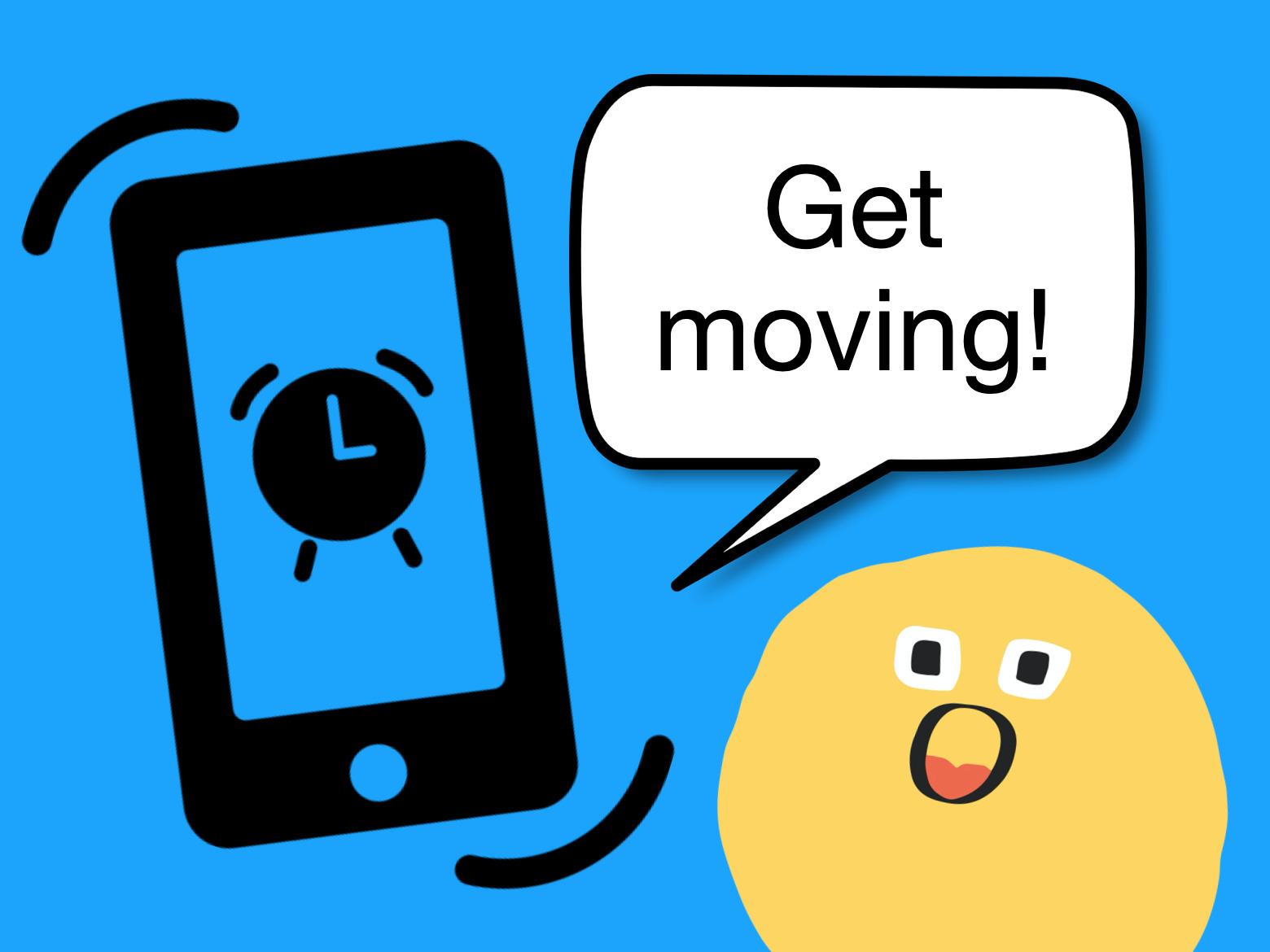
You should have a rough idea of how long it takes to get to school or work. Set your alarm for when you need to leave. When you hear your alarm, get moving.
Tiny Habit:
When I hear my alarm, I will pick up my bag and go.
It’s tempting to cram in a few more tasks before you leave for work or school (e.g., sending one more text or watching one more short video). But ask yourself, “Do I have time to do this?”
The answer is most likely no.
Tiny Habit:When I feel tempted to do another task, I will ask “Do I have time to do this?”
When I was a kid, there was no Internet and no smartphones. But we had morning cartoons on the TV.
These cartoons were fun to watch and could easily capture your attention. But you still had some awareness of the time because the time was always displayed in the corner of the screen.

The major problem with most social media apps is they don’t contain clear time cues. This is a deliberate design decision. They want you to lose track of time. Thirty minutes online can feel like three minutes.
The solution is to stay offline in the mornings. If you must go online, have a strict log-off time. I recommend setting an electronic timer for a set time or using an Internet Blocker app to kick you off.
I use an Internet blocker app called Freedom. This app cost me a bit of money but there’s a free alternative called Cold Turkey.
Tiny Habit:
When I feel the urge to go on social media in the morning, I will set a timer for 5 minutes.
Are you feeling time pressured and running late because you’re trying to do way too much?
Our modern culture encourages us to do more, be more, have more, sleep less, etc. It’s not healthy or sustainable.
If this is the case for you (i.e. you’re overcommitted), I realise it may not be your fault. Maybe your boss or teachers have unrealistic expectations about what you can accomplish in a day.
All that being said, your packed schedule may also be due to your inability to say no. Perhaps you feel like you need to say yes to every opportunity that comes your way to build an impressive resume and stand out from the crowd. If so, I get it (I’ve been there).
The major problem with doing too much is it leaves you feeling exhausted. You’re not able to fully engage in the task. As you do the activity, you’re worrying about the next thing you need to do.
If you’re doing a bunch of stuff and not enjoying it, perhaps it’s time to cut back on a few activities.
When you commit to doing less stuff (but more meaningful activities that align with your values), you can do that stuff better. You can also extract a lot more joy from the process.
Tiny Habit:
When I am presented with a new opportunity, I will ask “Is this important to me? Is it something I want to be doing with my time?”
In the book Excellent Advice for Living: Wisdom I Wish I’d Known Earlier, Kevin Kelly states:
“You don’t need more time because you already have all the time you will ever get; you need more focus”.
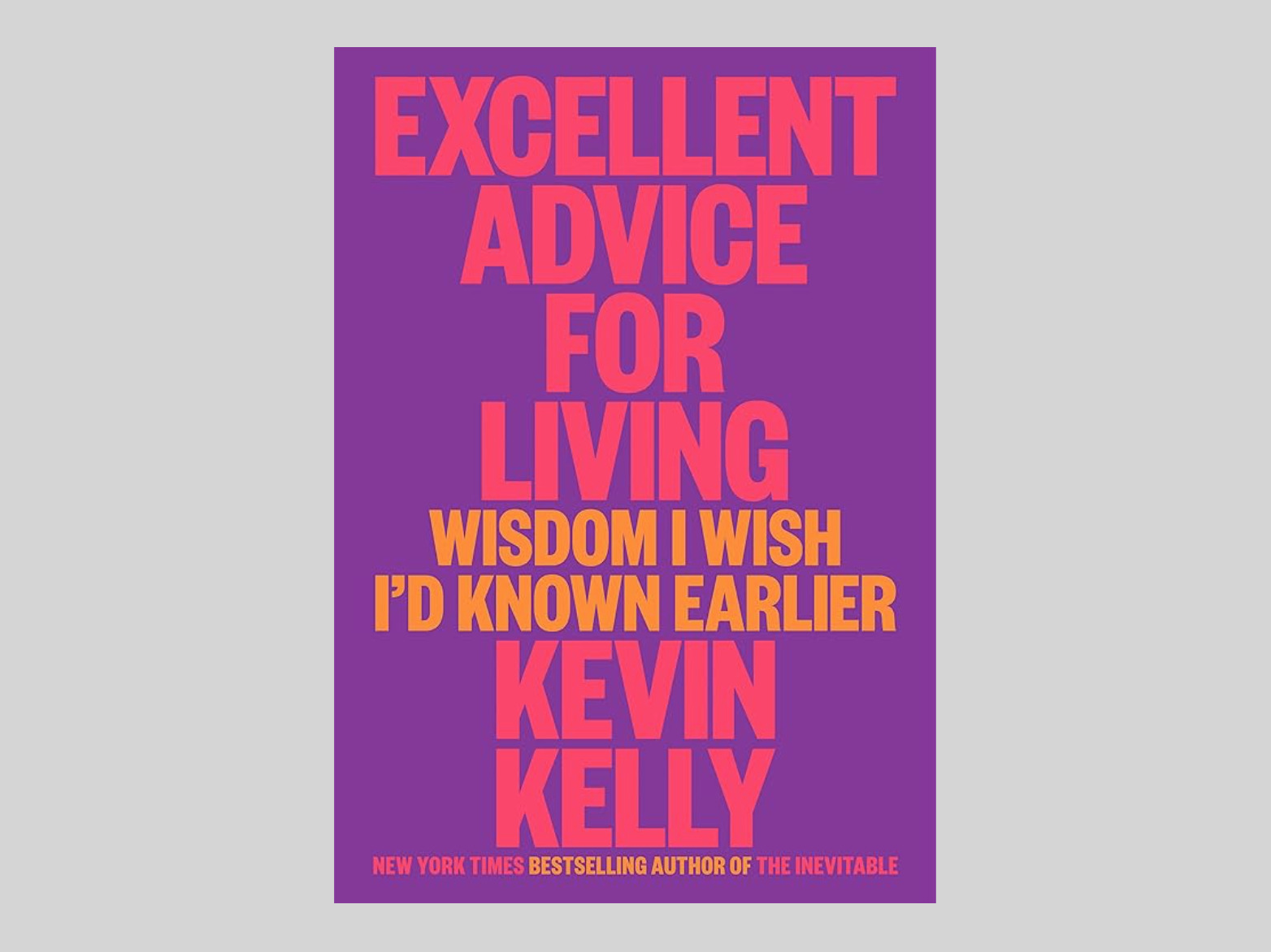
If you find yourself getting distracted by social media apps and YouTube, it’s time to double down on developing your focus muscles.
You can develop your focus muscles by adopting several different habits that relate to the food you put in your mouth, incorporating regular movement and rest breaks into your day, and creating a focus-friendly environment.
This is an area I’ve been working on for a while. What I’ve noticed is when I focus my mind on one task at a time, I can get twice as much done in the time I have available. But I also find that I enjoy the process a lot more, too.
Tiny Habits:
After I stand on my office mat, I will put away three objects on my desk (removing visual clutter)
When I notice my phone is on my desk, I will pick it up and put it in another room.
After I finish doing a deep work sprint (45 minutes), I will do some gentle shoulder rolls.
These habits may sound lame and boring, but they can inject a sense of power, control, ease and even happiness into your day.
When you’re less rushed, you’re less stressed. Because you’re less stressed, the people around you are also more likely to be less stressed (calm is contagious). It also means we end up with a more helpful and thoughtful society.
In our modern world, where we find ourselves increasingly polarised and tribalised, being less rushed and time pressured is something worth striving for.
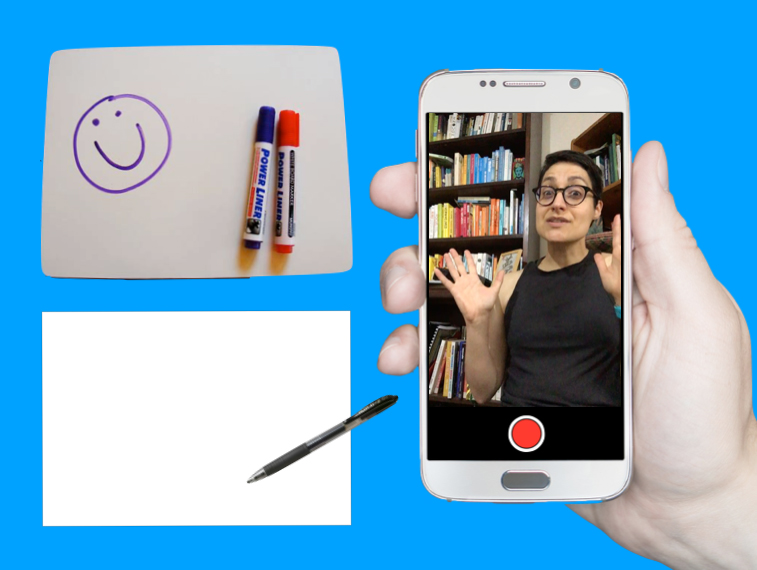
Research shows active recall (aka retrieval practice) is a highly effective strategy for remembering information. This strategy will take your studies and your grades to the next level.
Active recall involves bringing information to mind without looking at your books and notes.
I have spent the last 30 days experimenting with this excellent learning strategy. In this blog, I’ll share what I did and how I kept the process interesting for my brain.
I no longer need to study for tests and exams.
So, why did I spend 30 days using active recall strategies?
In my line of work, I need to constantly come up with new and original content to present to students. I also need to memorise this content. Why?
Because if I was to read from a sheet of notes or text heavy slides that would be really boring for students. I want to connect with students and to do this, I have to be able to deliver the content off the top of my head with speed and ease.
This is where active recall enters the picture.
Active recall helps to speed up the learning process. It allows you to learn more in less time.
Below I share some of the ways I use active recall to learn new presentation content. Keep in mind, you can use all of these strategies to prepare for an upcoming test or exam.
Whiteboards are wonderful learning tools. Here’s how I use a whiteboard to do active recall . . .
I push my speech notes to the side, so I can’t look at them. Then I grab a marker and say to myself, “What can you remember? Go!”.
I write out everything I can remember on the whiteboard. Once I’ve exhausted my memory, I pick up my notes and check to see how I went (using a red marker to make corrections).
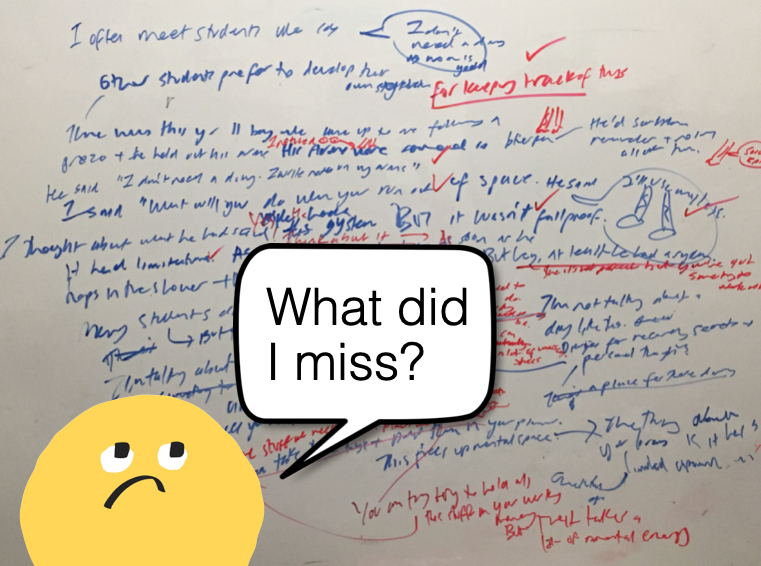
No whiteboard? No problem!
I pick up a pen and sheet of paper and start scribbling out whatever I can remember on the topic. When I get stuck, I pause and take a few deep breaths as I try to scan my brain for the information.
I regularly remind myself that it is okay to not remember the content. “This is how the process goes!”, I say to myself. There is no point beating myself up. That only leads to feelings of misery and not wanting to do active recall practice.
After having a shot at it, I take out my notes, pick up a red pen, and begin the process of checking to see how I went.
Sick of writing? I get it.
Try drawing out the information instead. Alternatively, you can use a combination of words and pictures, which is what I often do.
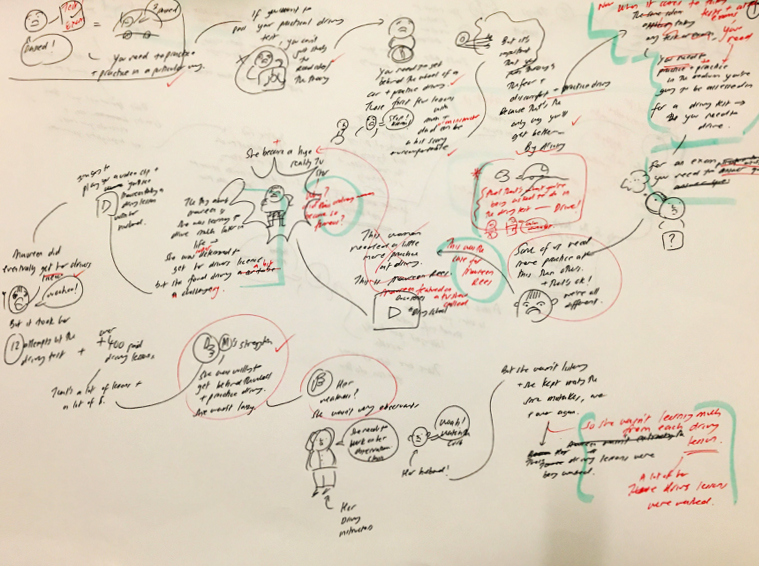
Grab a blank piece of paper (A3 size is best) and create a mind map of everything you can remember on a topic (no peeking at your notes). Then check your notes or the original mind map to see what you remembered correctly and incorrectly.
Writing and drawing out information can take time. If you want to speed up the process, you can talk to yourself.
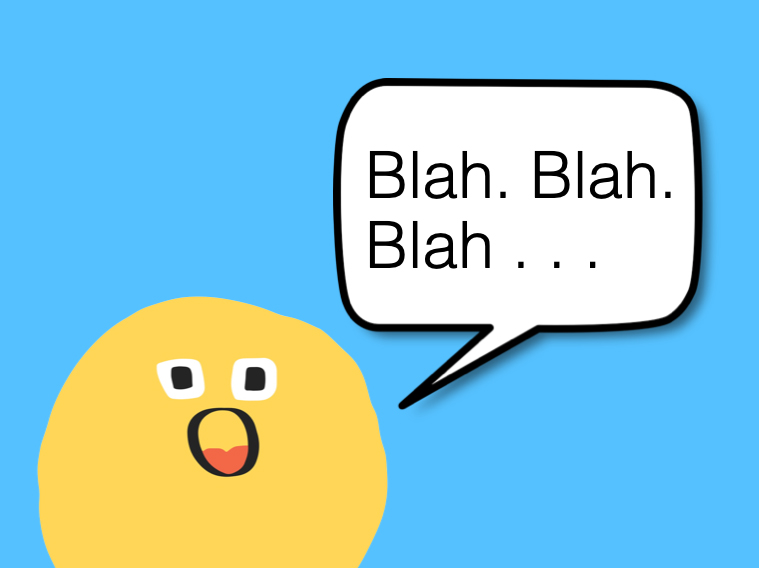
But don’t do this in your head. It’s too easy to just say “Yeah, yeah, I know this stuff!”. You need to speak it out loud as this forces you to have a complete thought. Then, check your notes to see how you went.
The only downside with this approach is you don’t have a tangible record of what you recalled, which brings me to the next strategy . . .
I make videos of myself presenting the content (without referring to my notes). Although I use special software and tools to make my videos, you don’t need any fancy equipment. Your phone will do the job. Here’s what you can do . . .
Set your phone up so the camera is facing you. Now hit the record button and tell the camera what you’re going to do active recall on. Have a shot at explaining the idea. Then stop recording and hit the play button.

Watching yourself struggle to remember information is often hard viewing. But this is where it’s super important to double down on telling yourself kind thoughts (e.g., “I’m still learning this content. It’s going to be rusty and feel clunky – that’s okay!”).
You need to take a deep breath and keep watching because the video will give you valuable feedback.
For example, if you stop midsentence and you don’t know how to proceed, that tells you something: you don’t know this stuff so well! Make a note. This part of the content needs your attention.
Hand your notes over to a friend, parent, or sibling. Now get them to ask you questions on the content.
I sat with my mum and showed her a print out of my slides for a new presentation. The slides were just pictures (no text).
As I went through the slides, I explained the ideas to mum. I made notes of any sections I was rusty on. Mum also asked lots of questions, which allowed me to think more deeply about the content.
When it came crunch time (a few days before the final presentation), I printed out my presentation slides (16 per page) and used each slide as a prompt. I’d look at the slide and say, “What do I need to say here?”.

Sometimes I wrote out what I’d be saying in relation to each slide (without looking at my notes). Then I checked my original notes to make sure I hadn’t forgotten anything.
It’s really important that you don’t skip the stage of checking to see how you went, especially as you become more confident with the content.
At times, I found myself thinking “I know this stuff! I don’t need to check my notes” but then another part would say, “You better just check . . . just to be on the safe side”.
I’m glad I forced myself to check because more often than not I would discover that I had missed a crucial point.
Zines are cute little booklets you can create on any topic you like. They are fun to make, so I thought I’d try making a mini zine on the main points of some new content I had to learn.
I folded up an A4 page into a booklet and then I sketched out the main points on each panel.
I create a deck of flashcards on some key ideas (question on one side and the answer on the back) and then I test myself with them.
I read the question and before flipping the card, I write out the answer on a sheet of paper or say it out loud. Then I check to see how I went.
The beauty of flashcards is they are small and portable (they can easily fit in your pocket or bag). Whenever you have a spare minute or two, you can get a little active recall practice in.
It’s not enough to do active recall just once on the content you need to learn. For best results, you want to practice recalling the information several times over a period of time.
I didn’t follow a strict schedule for the 30 days. I had my notes for each important chunk of information I had to learn pinned to eight different clipboards.
Every morning, I’d pick up a different clipboard and I’d practice that specific content. I knew as long as I’d had a good night’s sleep in between practice sessions that the information was being strengthened in my brain.
Doing active recall is a bit like doing a high intensity workout: it can be exhausting. But you must remember, just like a high intensity exercise session is an effective way to train and get fit, active recall is an effective way to learn. Unlike less effective strategies (e.g., rereading and highlighting), you can learn a lot in a short space of time with active recall.
The key is to expect the process to be a little uncomfortable. Don’t fight the discomfort. If you trust the process and persevere, it won’t be long before you begin to see amazing results.
Just because active recall is challenging to do that doesn’t mean you can’t have fun with it.
Using a combination of different active recall strategies is one way to keep things fresh and interesting for your brain. But you may wish to try the following things to add a little boost of fun to your active recall sessions:
• Use a different type of pen
• Use a different coloured pen
• Change the type of paper or notebook you use (e.g., instead of using lined paper, use blank A3 paper)
• Incorporate movement into your active recall sessions (e.g., walk and test yourself with some flashcards)
• Change your study environment (e.g., go to the library or study outside)
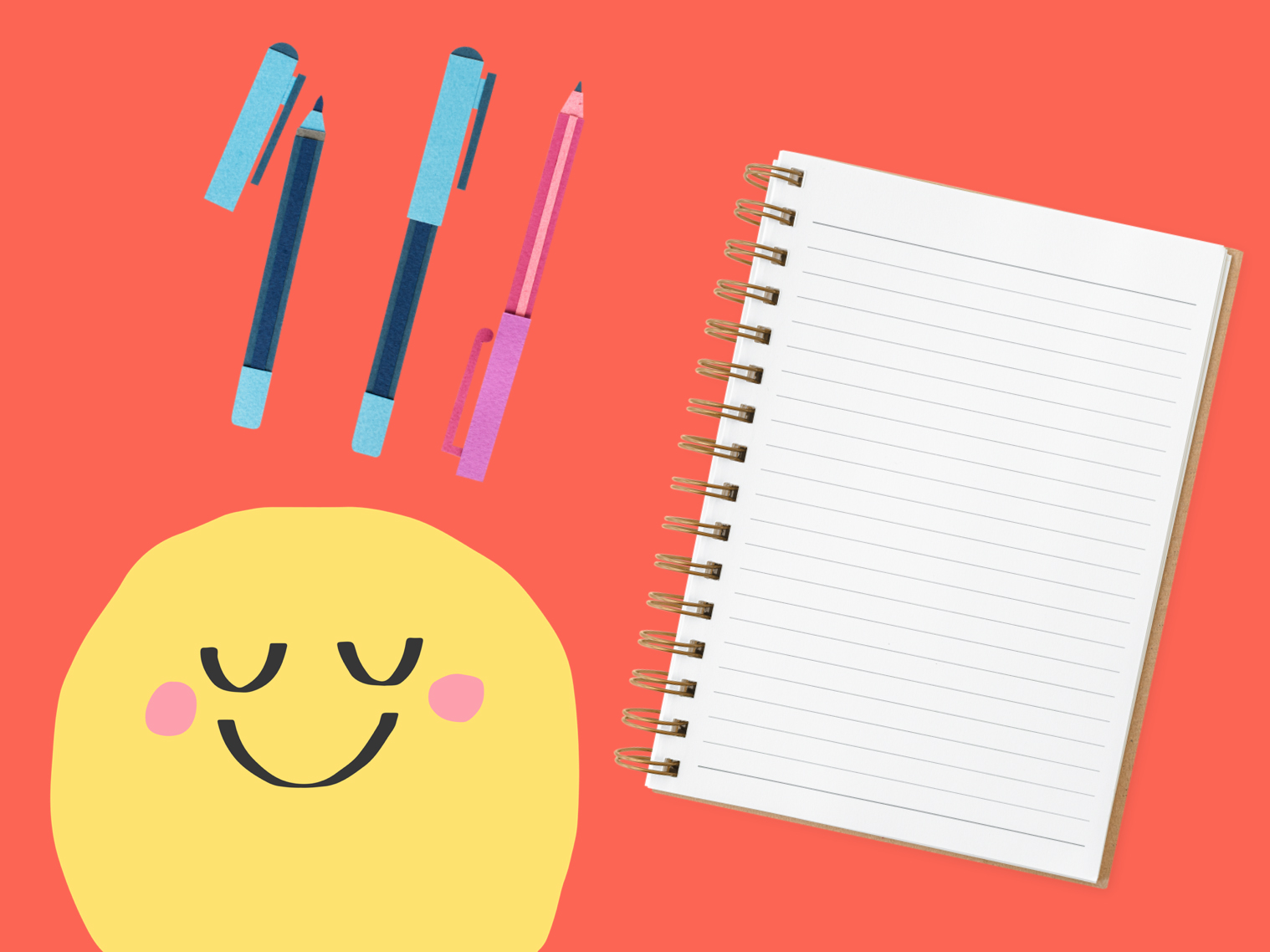
Like I said, active recall is challenging to do, especially when you first start learning new content. You can feel awkward and clumsy. For this reason, it’s easy to make excuses to get out of doing it (e.g., “I’m too tired”, “I’m not ready to do it”, and “It’s not the right time”).
This is where you need to harness the power of habits.
Find a set time in your day to do a little active recall practice. For instance, during my 30 days of active recall, I scheduled my practice sessions for first thing in the morning. I knew after I washed my face, I would sit down to practice.
Incorporating active recall into my morning routine worked really well for me. I was getting the hardest thing done first thing in the day. And once it was done, I could relax. It was done and dusted!
At a certain point, I became more confident with the content and I found I was on a roll. I felt motivated to do active recall.
This is when I started to look for spare moments in the day to squeeze in a few extra mini practice sessions.
For example, one day I found myself waiting in a car. I grabbed a paper shopping bag and started scribbling out the content onto the bag. As soon as I got home, I checked the shopping bag against my notes.

I hope you can see that there’s no one set way to do active recall. This is a highly effective strategy you can be creative with. As long as you’re testing yourself and checking to see how you went, you can’t go wrong.
And if you do make a mistake? It’s no big deal. If you check to see how you went, you won’t embed the error in your long-term memory.
Dr Jane Genovese delivers interactive sessions on learning to learn, combating procrastination, exam preparation, how to focus in the age of distraction, habit formation and much, much more!
Get FREE study and life strategies by signing up to our newsletter:
© 2024 Learning Fundamentals